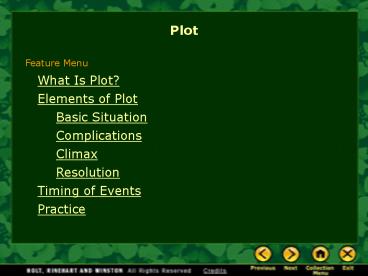Plot - PowerPoint PPT Presentation
1 / 14
Title: Plot
1
Plot
Feature Menu
What Is Plot? Elements of Plot Basic
Situation Complications Climax Resolution Timing
of Events Practice
2
What Is Plot?
Plot is what happens in a storythe sequence of
related events that makes a story hang together.
End of Section
3
Elements of Plot
A typical plot has four parts.
Climax most exciting/suspenseful moment
Complications new problems arise
Resolution problems are resolved
Basic Situation/Expositionconflict is introduced
End of Section
4
Basic Situation
The first part of a story is the basic situation,
or exposition. The writer introduces a character
who
- wants something very much
- encounters a conflict while trying to get it
5
Basic Situation
The main conflict in a story may be internal or
external.
- External conflict a struggle between a character
and an outside force
External climbing wall
- Internal conflict a struggle within the
characters own heart or mind
Internal fear
6
Basic Situation
Quick Check
What is the basic situation?
Bertha walked up and down and enjoyed herself
immensely, and thought to herself If I were not
so extraordinarily good I should not have been
allowed to come into this beautiful park and
enjoy all that there is to be seen in it, and
her three medals clinked against one another as
she walked and helped to remind her how very good
she really was. Just then an enormous wolf came
prowling into the park to see if it could catch a
fat little pig for its supper. from The
Storyteller by Saki
What conflict does Bertha face?
End of Section
7
Basic Situation
Quick Check
What is the basic situation?
Bertha walked up and down and enjoyed herself
immensely, and thought to herself If I were not
so extraordinarily good I should not have been
allowed to come into this beautiful park and
enjoy all that there is to be seen in it, and
her three medals clinked against one another as
she walked and helped to remind her how very good
she really was. Just then an enormous wolf came
prowling into the park to see if it could catch a
fat little pig for its supper. from The
Storyteller by Saki
Bertha is enjoying a walk in a beautiful park as
a reward for her goodness.
8
Basic Situation
Quick Check
What conflict does Bertha face?
Bertha walked up and down and enjoyed herself
immensely, and thought to herself If I were not
so extraordinarily good I should not have been
allowed to come into this beautiful park and
enjoy all that there is to be seen in it, and
her three medals clinked against one another as
she walked and helped to remind her how very good
she really was. Just then an enormous wolf came
prowling into the park to see if it could catch a
fat little pig for its supper. from The
Storyteller by Saki
She is threatened by a hungry wolf.
9
Complications
Next, a series of complications arisesevents
that make the characters situation more
difficult and heighten the suspense.
Complication
. . . and as she trembled the medal for
obedience clinked against the medals for good
conduct and punctuality. The wolf was just moving
away when he heard the sound of the medals
clinking and stopped to listen. . . . from The
Storyteller by Saki
End of Section
10
Climax
The plot reaches a climax. The climax
- is the most exciting or suspenseful moment
- decides the outcome of the conflict
He dashed into the bush, his pale grey eyes
gleaming with ferocity and triumph. . . . from
The Storyteller by Saki
End of Section
11
Resolution
The last part of the plot is the resolution, or
denouement.
- The problems are resolved in some way.
- The story endssometimes happily, sometimes not.
All that was left of her were her shoes, bits of
clothing, and the three medals for goodness.
from The Storyteller by Saki
End of Section
12
Timing of Events
Another important element of plot is the order in
which a writer tells the events.
13
Timing of Events
Identify which graphic
represents chronological order, flashback, and
flash-forward.
Quick Check
14
Timing of Events
Identify which graphic
represents chronological order, flashback, and
flash-forward.
Quick Check
Flashback
Chronological order
Flash-forward
15
Timing of Events
A writer may slow the pace of events to create
suspense or dramatize a moment.
Fast
Then, they saw a circle of gleaming eyes around
their camp.
Slow
There was no suggestion of form in the utter
blackness only could be seen a pair of eyes
gleaming like live coals. Henry indicated with
his head a second pair, and a third. A circle of
the gleaming eyes had drawn about their camp.
from White Fang by Jack London
End of Section
16
Practice
You can chart the plot of a story
by using a diagram like the one below. Fill in a
plot diagram for a fairy tale or a TV drama you
know well. Television and movies make frequent
use of flashbacks and foreshadowing. Insert those
time tricks on your plot diagram as well.
Climax
Complications
Event
Event
Event
Resolution
Basic Situation
End of Section
17
The End

